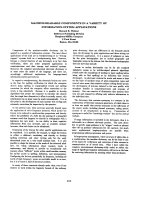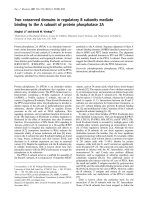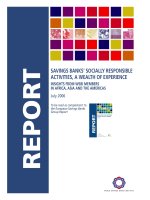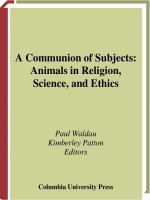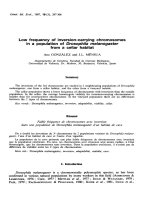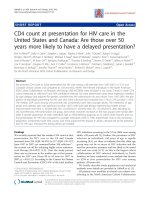Drawing in color: Animal - Lee Hammond
Bạn đang xem bản rút gọn của tài liệu. Xem và tải ngay bản đầy đủ của tài liệu tại đây (14.61 MB, 83 trang )
ART TECHNIQUE/DRAWING
UPC
UK £10.99 US $15.99
32144 (CAN $24.99)
EAN
ANIMALS
Lee Hammond
DRAWING IN COLOR
Hammond
ANIMALS
L
ee Hammond’s amazing easy-to-follow techniques enable
you to render a variety of wonderful animals, from cats
and dogs to horses, squirrels, tigers and more. These skills
can be used to draw any kind of mammal accurately.
Hammond’s special graphing system makes all the
difference, helping your brain translate the animal poses
you see into drawings on the page. You’ll also learn
other important illustration techniques, including layer-
ing, blending and shading. Additional guidelines help you
duplicate realistic eyes, ears, mouths, feet, fur, and hide.
You can start drawing TODAY—whether you’re eight
or eighty. Lee Hammond provides the know-how you
need to make it happen!
You can draw incredibly realistic animals—
even if you’ve never drawn before!
Look for these other exciting titles by Lee Hammond!
Drawing in Color
(A) (JOE) 200202084 REGENT F&W:DRAWING IN COLOR-ANIMALS (CVR) (WS)
32144 CM DIC ANIMALS 9/1/08 10:00 AM Page 1
F&W-Drawing in Color:Animals (RPS 02-4-51NT1) 175L
32144 FNT MTR 8/30/08 11:39 AM Page 1
ANIMALS
Lee Hammond
Drawing in Color
NORTH LIGHT BOOKS
CINCINNATI, OHIO
www.artistsnetwork.com
F&W-Drawing in Color:Animals (RPS 02-4-51NT1) 175L
32144 FNT MTR 8/30/08 11:39 AM Page 1
Polly “Lee” Hammond is an illustra-
tor and art instructor from the
Kansas City area. She owns and
operates a private art studio named
Take It To Art*, where she teaches
realistic drawing and painting.
Lee was raised and educated in
Lincoln, Nebraska, and established
her career in illustration and teach-
ing in Kansas City. Although she has
lived all over the country, she will
always consider Kansas City home.
Lee has been an author with
North Light Books since 1994. She
also writes and illustrates articles for
other publications, such as The
Artist’s Magazine.
Lee is continuing to develop new
art instruction books for North
Light and is also expanding her
career into illustrating children’s
books. Fine art and limited edition
prints of her work will also soon be
offered.
Lee resides in Overland Park,
Kansas, along with her family.
Note: You may contact Lee via
e-mail at
or visit her
Web site at .
*Take It To Art is a registered
trademark for Lee Hammond.
About the Author
Drawing in Color: Animals. Copyright © 2002 by Polly “Lee”
Hammond. Manufactured in China. All rights reserved. No part of this
book may be reproduced in any form or by any electronic or mechanical
means including information storage and retrieval systems without per-
mission in writing from the publisher, except by a reviewer who may
quote brief passages in a review. Published by North Light Books, an
imprint of F&W Publications, Inc., 4700 East Galbraith Road,
Cincinnati, Ohio 45236. (800) 289-0963. First edition.
Other fine North Light Books are available from your local bookstore, art
supply store or direct from the publisher.
06 05 04 03 5 4 3 2
Library of Congress Cataloging-in-Publication Data
Hammond, Lee 1957-
Drawing in color: animals / Lee Hammond.
p. cm.
Includes index.
ISBN 1-58180-273-0 (alk. paper)
ISBN-13: 978-1-60061-501-6 (EPUB)
[1. Animals in art. 2. Drawing Technique.] I. Title.
NC780 .H243 2002
743.6 dc21 2001059643
Editor: Bethe Ferguson
Production Coordinator: John Peavler
Cover Designer: Wendy Dunning
METRIC CONVERSION CHART
to convert to multiply by
Inches Centimeters 2.54
Centimeters Inches 0.4
Feet Centimeters 30.5
Centimeters Feet 0.03
Yards Meters 0.9
Meters Yards 1.1
Sq. Inches Sq. Centimeters 6.45
Sq. Centimeters Sq. Inches 0.16
Sq. Feet Sq. Meters 0.09
Sq. Meters Sq. Feet 10.8
Sq. Yards Sq. Meters 0.8
Sq. Meters Sq. Yards 1.2
Pounds Kilograms 0.45
Kilograms Pounds 2.2
Ounces Grams 28.3
Grams Ounces 0.035
F&W-Drawing in Color:Animals (RPS 02-4-51NT1) 175L
32144 FNT MTR 8/30/08 3:33 PM Page 2
Dedication and Acknowledgements
This book is dedicated to my grand-
daughter Taylor Marie. I hope you
continue to love animals and art as
much as I do. Thanks for being such
a fun little girl and adding so much
joy to my life! I love you!
—Grama Lee
I would also like to dedicate this
book to my guardian angel, Penny.
Thanks for watching over me and
keeping me from harm.
Of all the accomplishments in my life,
writing for North Light Books has
been one of the most rewarding. My
books have opened up an entire world
of friendships for me. How lucky we
are to live in this day and age, where
we have the technology available to
communicate across the globe.
I want to thank my readers, wher-
ever you may reside, for supporting
Taylor Marie
Age 6
PENNY
Prismacolor pencils on no. 7184 Cinnamon suede board
14" x 11" (36cm x 28cm)
my artistic goals. Your warm
thoughts and well wishes are grate-
fully received and appreciated. I wish
each and every one of you the very
best life has to offer.
A special thank you to everyone
at North Light Books for making
this dream possible!
F&W-Drawing in Color:Animals (RPS 02-4-51NT1) 175L
32144 FNT MTR 8/30/08 11:44 AM Page 3
CHAPTER ONE
You Can Do It! 5
CHAPTER TWO
Getting Started 7
CHAPTER THREE
The Different “Looks”
of Colored Pencil
12
CHAPTER FOUR
Technique 15
CHAPTER FIVE
Basic Shapes
and Shading
17
CHAPTER SIX
Graphing 24
CHAPTER SEVEN
Drawing Animal Features
in Prismacolor
30
Table of Contents
CHAPTER EIGHT
Hair and Fur 43
CHAPTER NINE
Verithin Pencils 53
CHAPTER TEN
Prismacolor Pencils 57
CHAPTER ELEVEN
Studio Pencils 61
CHAPTER TWELVE
Colored Pencils
on Suede
66
CHAPTER THIRTEEN
Other Options 76
F&W-Drawing in Color:Animals (RPS 02-4-51NT1) 175L
32144 FNT MTR 8/30/08 11:44 AM Page 4
5
You Can Do It!
DRAWING BY A STUDENT, LAURA TIEDT
The first attempt is not necessarily a bad
drawing. You can see how the student was
hesitant about applying the colored pencil. In
the end, the drawing looked incomplete.
Colored pencil can be a very frustrat-
ing and confusing medium. As an art
instructor, I see many students strug-
gling in the beginning to learn the
various techniques.
As with anything else in life, it just
takes some understanding and a lot
of practice to become comfortable
with something new.
I tell my students to relax when
they first begin. Not all artistic
attempts need to be wonderful pieces
of art which are suitable for framing.
Rarely do our first attempts create
the results we are striving for. You
must not be afraid to experiment.
I’ve been a professional artist for
many years. However, I still struggle
You Can Do It!
Welcome to the wonderful world of colored
pencil!
ATTEMPT TWO BY LAURA TIEDT
This second attempt looks much more realis-
tic. The student used layers of color and a
heavier application with the pencils, which
gave the drawing more depth and realism.
Chapter One
later—when I matured artistically—I
figured out my problem. I appro-
ached drawing with colored pencil
differently and learned to love it.
Unfortunately, back when I was
beginning, few books were written
on colored pencil. I was forced to
learn through trial and error. You
now have a wonderful selection of
books available by extremely gifted
artists. Everything you need to know
is at your fingertips. All you really
need to do is practice.
Look at the example below. It is
the progress of a typical art student.
Your progress may appear very
similar.
at times and throw away projects
that just plain do not work out. It’s
okay. Struggling and experimenting
are part of the process and should
not be seen as failures. Experiments
are just as important as the final
pieces. Learn to embrace them both!
I always remind the beginner that I
too was a beginner and was once in
their shoes. I honestly didn’t like col-
ored pencils when I first began work-
ing with them. I was too conditioned
as a child to use pencils to just “fill
in” color. The process of layering col-
ors, or blending colors, escaped me at
first. My projects resembled crayon
drawings, and I blamed myself for
my lack of talent. However, years
F&W-Drawing in Color:Animals (RPS 02-4-51NT1) 175L
32144 i Ch 1 8/30/08 11:45 AM Page 5
6
Drawing in Color: Animals
MEOWSER LOOKING OUT THE WINDOW
Verithin pencils on no. 2259 Antique White mat board
12" x 9" (31cm × 23cm)
Nothing is more fun for me, as an
artist, than turning an ordinary snap-
shot into a memorable piece of art. I
use my camera and my artwork as a
way of documenting my life and
remembering special things.
Illustration is the art of telling a
story through pictures. This drawing
takes my snapshot and turns it into
something more meaningful. While
drawing this piece, I was immediately
transported back to that moment in
time, remembering everything as I
experienced it. Artwork is magical
that way. The finished product is
more than a drawing, it is a memory.
Note: During the writing of this
book my cat, Meowser, unfortu-
nately died due to illness. Now these
illustrations are more meaningful to
me than ever.
AN ORDINARY SNAPSHOT CAN BECOME
INTERESTING ARTWORK
This is a snapshot I took of Meowser. It isn’t
that good of a picture, but the story behind it
is cute. All kitties like to look out the window,
and mine is no exception. This time there
was a bird outside, and Meowser watched it
for quite a while. Of course, as soon as I
grabbed the camera he had to look at me
instead.
F&W-Drawing in Color:Animals (RPS 02-4-51NT1) 175L
32144 i Ch 1 8/30/08 11:46 AM Page 6
7
Getting Started
Getting Started
Chapter Two
Each brand of colored pencil has a
different appearance when used.
Each pencil is made differently to
create an unique effect. I can’t easily
answer which pencil is “the best,” or
which one I like the most. It really
depends on the final outcome and the
“look” I want my work to have.
Rarely will I use just one brand of
pencil to complete a project. Any one
of them alone is somewhat limited. I
have found that by using a combin-
ation of pencils, I can create more
variety in my techniques. This
enables me to achieve the look I’m
trying to accomplish. The following
is an overview of the four types of
pencils I like the most.
PRISMACOLOR PENCILS
Prismacolors have a thick, soft wax-
based lead that provides a heavy
application of color. They are opaque
and will completely cover the paper
surface. They are excellent for ach-
ieving smooth, shiny surfaces and
brilliant colors. The colors can be
easily blended to produce an almost
“painted” appearance to your work.
They come in a huge selection of
colors: 120 or more.
VERITHIN PENCILS
Verithins also have wax-based lead,
but have a harder, thinner lead than
Prismacolors. Because of their less
waxy consistency, they can be sharp-
ened to a very fine point. They are
compatible with Prismacolor but are
more limited in their color range,
which is thirty-six. I use Verithins
whenever I want the paper to show
through because they cannot build up
to a heavy coverage. They can give you
very sharp, crisp lines. Verithins are
good for layering colors without the
colors mixing together. Prismacolors
can give your work a painted appear-
ance; Verithins give your work more
of a “drawn” look.
Using the Proper Pencils
Prismacolor pencils
Verithin pencils
F&W-Drawing in Color:Animals (RPS 02-4-51NT1) 175L
32144 i Ch 2 8/30/08 11:47 AM Page 7
8
Drawing in Color: Animals
STUDIO PENCILS
Studio pencils, by Derwent, are
somewhat like a composite of the
other brands. They are a clay-based
pencil with a range of seventy-two
colors. Applied heavily, they can cre-
ate deep, dark hues. Applied lightly,
they can be blended with a tortillion
(see
page 10). They also have a sister
pencil called the Artists line, which is
the same formulation with a bigger
lead diameter. I use the Studio line
because I prefer a sharper point.
Also, because it is clay based, it will
not build up color as well as Prisma-
color and will give more of a matte
(nonglossy) finish.
NEGRO PENCILS
Using the Negro clay-based black
pencil is an excellent way to achieve
deep, rich black in your work with-
out a hazy wax buildup. This is the
blackest pigment I’ve ever found in a
colored pencil. It comes in five
degrees of hardness, ranging from
soft (1) to hard (5).
Studio pencils.
Negro pencils.
F&W-Drawing in Color:Animals (RPS 02-4-51NT1) 175L
32144 i Ch 2 8/30/08 11:48 AM Page 8
9
Getting Started
As with anything we do, the quality
of our colored pencil artwork is
determined by the quality of the tools
we employ for the job. The following
is a list of supplies you will need to
succeed.
PAPER
The paper you use with colored pen-
cils is critical to your success. There
are many fine papers on the market
today. You have hundreds of options
of sizes, colors and textures. As you
try various types, you will undoubt-
edly develop your personal favorites.
Before I will even try a paper for
Tools of the Trade
colored pencil, I always check the
weight. Although there are many
beautiful papers available, I feel
many of them are just too thin to
work with. I learned this the hard
way, after doing a beautiful drawing
of my daughter only to have the
paper buckle when I picked it up.
The crease formed was permanent,
and no amount of framing kept my
eye from focusing on it first. From
that point on, I never used a paper
that could easily bend when picked
up. The more rigid, the better!
Strathmore has many papers that I
often use. The following is a list of
Prismacolor pencils on suede board.
Prismacolor pencils on mat board.
Strathmore Renewal
paper has soft colors
with the look of tiny
fibers in it. Artagain,
also by Strathmore,
has a speckled
appearance and
deeper colors. Both
have a smooth sur-
face.
F&W-Drawing in Color:Animals (RPS 02-4-51NT1) 175L
32144 i Ch 2 8/30/08 11:48 AM Page 9
10
Drawing in Color: Animals
the ones I personally like to use the
most and recommend to my students.
Artagain—Artagain is a recycled paper
by Strathmore that has somewhat of
a flannel appearance to it. This 60-lb.
(130gsm) cover-weight paper comes
in a good variety of colors. Although
it has a speckled appearance, its sur-
face has no noticeable texture. It is
available in both pads and single
sheets for larger projects.
Renewal—Renewal is another Strath-
more paper, very similar to Artagain,
but it has the look of fibers in it
instead of speckles. I like it for its soft
earth tones.
Crescent Mat Board—My personal
favorite is Crescent because of the
firmness of the board. It is already
rigid and doesn’t have to be taped
down to a drawing board. This makes
it very easy to transport in a portfo-
lio. Its wide range of colors and tex-
tures is extremely attractive. Not only
do I match the color to the subject I
am drawing, I will often use the same
color of mat board when framing the
piece to make it color coordinated.
Crescent Suede Board—Crescent Suede
Board is another one of my favorites.
It has a surface like suede or velvet-
een. I have developed a technique
using Prismacolor that makes it look
like pastel when applied to this fuzzy
surface.
PENCIL SHARPENERS
Pencil sharpeners are very important
with colored pencils. Later in the
book, you will see how many of the
techniques require a very sharp point
at all times. I prefer an electric sharp-
ener, or a battery-operated one when
traveling. A handheld sharpener
requires a twisting motion of the
arm. This is usually what breaks off
the pencil points. The motor-driven
sharpeners allow you to insert the
pencil straight on, reducing breakage.
If you still prefer a handheld sharpen-
er, spend the extra money for a good
metal one, with replacement blades.
ERASERS
I suggest that you have three different
erasers to use with colored pencil: a
kneaded eraser, a Pink Pearl eraser
and a typewriter eraser. Although
colored pencil is very difficult, if not
impossible, the erasers can be used to
soften colors as you draw.
The kneaded eraser is like a squishy
piece of rubber, good for removing
your initial line drawing as you
work. Because of its soft, pliable feel,
it will not damage or rough up your
paper surface.
The Pink Pearl eraser is a good
eraser for general cleaning. I use it the
most when I am cleaning large areas,
such as backgrounds. It is also fairly
easy on the paper surface.
The typewriter eraser looks like a
pencil with a little brush on the end
of it. It is a highly abrasive eraser,
good for removing stubborn marks
from the paper. It can also be used to
get into tight places or to create clean
edges. However, great care must be
taken when using this eraser, because
it can easily damage the paper and
leave a hole.
MECHANICAL PENCIL
I always use a mechanical pencil for
my initial line drawing. Because the
lines are so light, unlike ordinary
drawing pencils, they are easily
removed with the kneaded eraser. As
you work, replace the graphite lines
with color.
TORTILLIONS
Tortillions are cones of spiral-wound
paper. They are used to blend after
you have applied the colored pencil
to the paper. I use them only with
Studio pencils. Prismacolor is much
F&W-Drawing in Color:Animals (RPS 02-4-51NT1) 175L
32144 i Ch 2 8/30/08 11:49 AM Page 10
11
Getting Started
too waxy for this technique. Verithins
work somewhat but don’t blend as
evenly as the clay-based pencils.
ACETATE GRAPHS
Acetate graphs are overlays to place
over your photo reference. They have
grid patterns on them that divide
your picture into even increments,
making it easier to draw accurately.
I use them in both 1-inch (3cm) and
1
⁄2-inch (1cm) divisions. They can be
easily made by using a permanent
marker on a report cover. You can
also draw one on paper and have it
copied to a transparency on a copy
machine.
TEMPLATES
Templates are stencils that are used
to obtain perfect circles in your
drawing. I always use one when
drawing eyes to get the pupils and
irises accurate.
MAGAZINES
The best source for drawing material
is magazines. I tear out pictures of
every subject and categorize them into
different bins for easy reference. When
you are learning to draw, magazines
can provide a wealth of subject matter.
When drawing people, there is noth-
ing better than glamour magazines.
CRAFT KNIVES
Craft knives are not just for cutting
things; they can actually be used as
drawing tools. When using Prisma-
color, I use the edge of the knife to
gently scrape away color to create
texture such as hair or fur. A knife
can also be used to remove unwanted
specks that may appear in your
work. As you can probably imagine,
it is important to take care with this
approach to avoid damaging the
paper surface.
FIXATIVES
The type of spray that you use to fix
your drawing depends again on the
look you want your piece to ulti-
mately have. I use two different types
of finishing sprays, each one with its
own characteristics.
Workable fixative—The most common
of the sprays, the workable fixative is
undetectable when applied. The term
“workable” means that you can con-
tinue drawing after you have applied
the spray. Experience has taught me
that this is more true for graphite and
charcoal than it is for colored pencil.
I have found fixative to actually
behave as a resist. I use it whenever I
don’t want the appearance of my
work to change. When using
Prismacolor, the wax of the pencil
will rise to the surface, making the
colors appear cloudy and dull.
Workable fixative will stop this
“blooming” effect and make the
colors true again.
Damar varnish—I use this spray when
I want a high-gloss shine applied to
my Prismacolor drawings. It will give
the drawing the look of an oil paint-
ing and make the colors seem shiny
and vivid. (Its primary use is to seal
oil paintings.) I will often use this
when drawing fruit and flowers, but
it will also make a portrait beautiful.
HORSE HAIR DRAFTING BRUSH
This is an essential tool when you are
drawing, but even more so when
using colored pencil. Colored pencil,
particularly Prismacolor, will leave
specks of debris as you work. Left on
the paper, they can create nasty
smudges that are hard to erase later.
Brushing them with your hand can
make it worse, and blowing them off
will create moisture on your paper,
which will leave spots. A drafting
brush gently cleans your work area
without smudging your art.
Note—
When a fixative is used on colored pencils that
have been blended with a tortillion, the pig-
ment can seem to melt into a watercolor
appearance. The colors will appear much
F&W-Drawing in Color:Animals (RPS 02-4-51NT1) 175L
32144 i Ch 2 8/30/08 11:50 AM Page 11
WHITE SQUIRREL
Prismacolor pencils
on no. 3308 Oxford
mat board
10" x 8" (25cm x 20cm)
Drawing in Color: Animals
12
The Different“Looks” of
Colored Pencil
Drawing in colored pencil is a some
what deceptive term because there
are many types of colored pencils,
each with their own formulation.
Each brand of pencil has its own
unique look, produces a different
effect and requires a different tech-
nique. When deciding which pencil
to use, you must decide which look
you want your artwork to have.
When you begin a new project,
you must first decide upon the look
you would like to achieve, then find
the pencil that will create that look.
Each of these drawings has its own
look. Some are bold and bright, oth-
ers soft and delicate.
Because of the different colors and
textures found in the varying species
of animals, there is not one pencil
that can always give you what you
need. You will require a variety of
pencils, and use many methods, to
Chapter Three
COLORS USED
Squirrel: White, French Grey 20%, Light
Umber, Dark Umber, Bronze, Sepia (fur)
Salmon Pink (ears) Tuscan Red and Black
(eye).
Background: Limepeel, Apple Green,
Bronze, Light Umber, Yellow Ochre, Deco
Yellow and White.
Tree Bark: Dark Umber, Light Umber, French
Grey 20%, Deco Yellow, Black and White.
This drawing was done on smooth mat board. The smooth sur-
face allows you to apply firm pressure to the pencil, completely
covering the paper surface. This is called burnishing. That is how I
made the white fur fill in and the tree bark to appear textured.
Because of the opaque nature of these pencils, you can draw on
dark-colored papers. This board was a medium gray color, and
the white showed up beautifully. Whenever I need to apply heavy
layers of color, or build up extreme texture, I use Prismacolor.
Note: This drawing was sprayed with workable fixative when com-
pleted, to prevent wax bloom.
F&W-Drawing in Color:Animals (RPS 02-4-51NT1) 175L
32144 i Ch 3 8/30/08 11:51 AM Page 12
13
The Different “Looks “ of Colored Pencil
capture all of the different animals
seen in nature.
Each of these drawings has a dis-
tinct look, and all were done with a
different brand of pencil. Before I
begin a piece, I have to analyze the
characteristics of my subject and
decide which pencil creates the look I
desire.
PRISMACOLOR PENCILS
Prismacolor pencils have a heavy
wax content and deep pigments, and
therefore go on very concentrated
and opaque. Prismacolor pencils are
known for their thick leads and rich
colors.
VERITHIN PENCILS
Verithin are good pencils to use when
drawing animals. They are made by
the same manufacturer as Pris-
macolor but have a thinner lead,
which produces fine, thin lines. They
also have less wax and go on a little
“drier” than Prismacolor.
Verithin pencils also work well on
dark paper. This rabbit was drawn
on a medium gray board, and the
white pencil shows up beautifully.
Verithin pencils do not burnish
like Prismacolor. Instead, the colors
“layer” without blending together.
The result is a highly textured
appearance.
JACK RABBIT
Verithin pencils on no. 3331 Sage mat board
14" x 11" (36cm x 28cm)
Study the drawing of the rabbit closely, and
you can see different layers of colors. They
were applied with short, quick strokes and
look just like the layers of fur. Whenever I
need to replicate coarse hair or layered fur, I
use Verithin pencils.
COLORS USED
Rabbit: Black, Dark Brown, Terra Cotta and
White.
Background: Dark Green and Black.
F&W-Drawing in Color:Animals (RPS 02-4-51NT1) 175L
32144 i Ch 3 8/30/08 11:52 AM Page 13
14
Drawing in Color: Animals
KIMBER AND THE DRINKING GLASS
Studio pencils on no. 912 India mat board
16" x 12" (41cm x 30cm)
Sometimes a subject will have a combination of textures to capture,
and they will require a special application of the pencils to create. To
render this drawing, I used a combination of techniques. I first placed
in the colors of the puppy and blended the colors smooth with a tor-
tillion—this creates the contours and form of the body. I then placed
more color on top of the blended tones to create the texture of the fur.
I used this technique for the entire drawing. Look at all the areas of
the piece and you can see where I used both blending and pencil lines
for realism.
STUDIO PENCILS
Studio pencils are manufactured by
Derwent. They are clay-based pencils
as opposed to the wax-based pencils
we looked at previously. Because of
their formulation, these pencils have
the advantage of being easily blend-
ed with a stump or tortillion (see
page 10). The result is a smooth,
subtle blending of tone.
Another advantage to using these
pencils is that you can use them
heavily and achieve dark color and
deep tones. Because they are not
wax-based, however, you will not get
the same effects when burnishing as
you would with Prismacolor.
COLORS USED
Puppy: Chocolate Brown, Ivory Black, Terra
Cotta, Burnt Yellow Ochre, Venetian Red
and Copper Beech.
Drinking Glass: Ivory Black, Venetian Red,
Turquoise Blue and Cedar Green.
Background: Cedar Green, Chocolate
Brown, Olive Green and Ivory Black.
Foreground: Ivory Black, Chocolate Brown
and Turquoise Blue.
Note —
The colors of the puppy and the background
are all reflecting into the glass. Since glass and
water are clear, they are drawn using the sur-
rounding colors that bounce off of the shiny
surfaces.
F&W-Drawing in Color:Animals (RPS 02-4-51NT1) 175L
32144 i Ch 3 8/30/08 11:56 AM Page 14
15
Technique
LAYERING
To best teach layering I like to start
my students out with Verithin pen-
cils. This technique also carries over
to the other brands as well. Once you
learn how to layer colors well with
these pencils, using the other brands
will be easy.
Layering is the process of using a
very sharp pencil point and applying
the tone gradually and evenly. Do not
let the pencil point become dull. This
alters the width of the lead and
makes the drawing look crayon-like.
A colored pencil has a “feel” to it.
When drawing darker areas, I have a
tendency to hold my pencil closer to
the tip allowing me to use more pres-
sure without breaking the lead. As I
move to lighter areas I pull back,
holding the pencil further back from
the tip. This helps me touch the
paper surface lightly, giving it a softer
appearance.
You should blend your tone very
gradually as they fade from dark to
light. There should be no choppiness
between tones, no definite line where
one tone ends and another begins.
Practice first with value scales. The
more you do, the more proficient you
will become. Start with just black
pencil at first, layering from dark to
light by altering the pressure you
apply to the pencil. Let the tone fade
into the color of the paper.
It is important when you apply the
pencil that your lines are very close
together so they fill in any white
space. Going back and forth slowly
helps you do this.
BURNISHING
Once you are comfortable with the
Technique
Chapter Four
DON’T! This type of
pencil application
makes your work
look like scribbled
crayons.
A value scale drawn
correctly with
Verithin pencils. The
tones fade gradually
without visible pencil
lines. This is called
layering.
A value scale drawn
with Prismacolor
pencils. This is
called burnishing.
A value scale drawn
with Studio pencils.
This is called
blending.
layered approach, try Prismacolor
pencils. You will see how different
the pencils are.
Begin with three colors of pencils:
Black, White and Cool Grey 50%.
This process will begin the same as
layering, but you will continue to
build up the color until it completely
covers the paper surface. This is
where you will use burnishing, a
technique in which you use a lighter
color to blend the darker colors into
one another.
For example, start the value scale
with the Black and then apply the
Cool Grey 50% next to and overlap-
ping the Black. The lighter color
(Cool Grey 50%) going into the
darker one (Black) will soften the
two colors together. Next, add White
into and overlapping the Cool Grey
50%. Continue burnishing the
F&W-Drawing in Color:Animals (RPS 02-4-51NT1) 175L
32144 i Ch 4 8/30/08 11:57 AM Page 15
16
Drawing in Color: Animals
colors, alternating the addition of
light and dark, until they blend
together for a smooth, gradual look.
This technique resembles a “painted”
appearance.
Prismacolor drawing is the process
of applying many colors, each one
into the others, always using a lighter
color to burnish. Sometimes you
have to layer and burnish many times
to get the look you want. This tech-
nique requires a lot of patience, but
the nice thing about it is that it’s best
done with a dull pencil point.
BLENDING
Blending is the application of clay-
based pencils that are smoothed out
with the aid of a tortillion or stump.
The tones appear very smooth and
gradual. There appears to be no visi-
ble pencil lines, and the tones fade
into one another, transitioning
smoothly.
The following value scales show
how each pencil appears when
applied, revealing different, distinct
personalities. Is one method better
than another? No! I recommend
learning them all.
A value scale in
Prismacolor pencils
(burnished).
A value scale in
Verithin pencils
(layered).
A value scale in
Derwent Studio
pencils (blended).
F&W-Drawing in Color:Animals (RPS 02-4-51NT1) 175L
32144 i Ch 4 8/30/08 11:58 AM Page 16
17
Basic Shapes and Shading
Chapter Five
Basic Shapes and Shading
ds
Because it is important to fully under-
stand what it takes to create depth
and realism in your work, I begin all
of my books with the same informa-
tion: the five elements of shading and
practice exercises of the sphere. The
five elements of shading can be found
in every three-dimensional shape. The
five elements of shading are as fol-
lows (listed in order from darkest to
lightest):
1. Cast shadow. This is the darkest
part of your drawing. It is under-
neath the sphere, where no light
can reach. It gradually gets lighter
as it moves away from the sphere.
2. Shadow edge. This is where the
sphere curves and the rounded
surface moves away from the
light. It is not the edge of the
sphere, but is inside, parallel to
the edge.
Shadow Edge
Cast Shadow
Full Light
Halftone area
Reflected Light
3. Halftone area. This is the true col-
or of the sphere, unaffected by
either shadows or strong light. It is
found between the shadow edge
and the full light area.
4. Reflected light. This is the light
edge seen along the rim of the
sphere. This is the most important
element to include in your draw-
ing to illustrate the roundness of
the surface.
5. Full light. This is where the light is
hitting the sphere at its strongest
point.
F&W-Drawing in Color:Animals (RPS 02-4-51NT1) 175L
32144 i Ch 5 8/30/08 1:01 PM Page 17
18
Drawing in Color: Animals
Basic Shapes
THE SPHERE
Look for the five elements of shading here.
THE EGG
This can be seen in the shape of an animal’s
head, and also in the body.
THE CYLINDER
This shape can be seen in the neck area of an
animal, and also in the trunks of trees.
THE LONG CYLINDER
This can be found in the legs of an animal. It
also can be found in the necks of long-necked
animals, such as giraffes. The small limbs
and branches of a tree will also be made up
of this shape.
THE CONE
This can be seen in the shape of a bird’s
beak.
F&W-Drawing in Color:Animals (RPS 02-4-51NT1) 175L
The following are all of the basic
shapes that can be seen when draw-
ing animals. Each one has had the
five elements of shading applied,
giving them the illusion of form and
realism. Each of these shapes should
be drawn and practiced over and
over, until the process becomes sec-
ond nature to you.
As you analyze these shapes, try to
think of where each of them would
be found in the shapes of animals
and their surroundings. Think of oth-
er subject matter as well, and you
will see the importance of including
these forms in your artwork.
32144 i Ch 5 8/30/08 1:07 PM Page 18
19
Basic Shapes and Shading
Using this step-by-step example,
practice drawing the sphere. I have
used Verithin pencils for this exercise.
After drawing the sphere, practice
drawing the egg also. Apply the five
elements of shading as well. The
more of this you do now, the better
your drawings will be later.
1
Trace around a circular object, or use a template to
give yourself a round outline. With Dark Brown, add
the cast shadow below the sphere. Also add the shadow
edge. Remember, this does not go to the edge of the
sphere, but is inside, parallel to the edge. The space
between will become the reflected light area.
2
Add Poppy Red, overlapping the Dark Brown that is
already there. You are now creating the halftone
area. Work up gradually to the light area. Place some
Poppy Red below the sphere, over the cast shadow and
around to the other side. This gives you the illusion of a
tabletop.
3
With Canary Yellow, lightly overlap all of the colors
already there. Lighten your touch and gradually fade
into the color of the paper in the full light area.
COLORS USED
Dark Brown, Poppy Red and Canary Yellow.
Drawing a Sphere Step-by-Step
F&W-Drawing in Color:Animals (RPS 02-4-51NT1) 175L
32144 i Ch 5 8/30/08 1:07 PM Page 19
20
Drawing in Color: Animals
For additional practice, use this
example of a step-by-step egg. It has
been drawn with Studio pencils and
blended with a tortillion. It has a
smoother look to it than the sphere
exercise before, doesn’t it?
1
Lightly sketch an outline of an egg with your
mechanical pencil. Go over it lightly with Chocolate
Brown. Place the cast shadow below the egg. Lightly
apply the shadow edge, leaving room for the reflected
light. The light is coming from the front on this example,
so the shadow areas are off to the sides.
2
Build your tone with the Chocolate Brown until it
looks like mine. This area is the halftone. Lighten
your touch as you move toward the full light area.
3
With a tortillion, smooth the tones. Begin in the dark
areas and work toward the lighter ones, lightening
your touch as you go. Can you see how the color changes
when blended? It takes on a warmer appearance.
COLORS USED
Chocolate Brown
Drawing an Egg Step-by-Step
F&W-Drawing in Color:Animals (RPS 02-4-51NT1) 175L
32144 i Ch 5 8/30/08 1:08 PM Page 20
21
Basic Shapes and Shading
Lightly sketch the shape of the cylinder with the mechanical pencil.
Apply the cast shadow with Dark Brown. Soften the edge as it comes
away from the cylinder with Light Umber and then Beige. Use the
lighter colors to soften the tones together.
Apply the shadow edge with Dark Brown. Lighten your touch as you
move to the halftone area. Overlap the Dark Brown with Light Umber.
Use the lighter color to blend the two together. Lighten your touch as
you fade into the full light area.
With Beige and White, create the full light area. Blend the Beige into
the Light Umber you used previously. Blend White into the Beige or
the full light.
COLORS USED
Dark Brown, Light Umber, Beige and
White.
The Cylinder
F&W-Drawing in Color:Animals (RPS 02-4-51NT1) 175L
32144 i Ch 5 8/30/08 1:09 PM Page 21
22
Drawing in Color: Animals
These line drawings show how the
overall form of an animal can be bro-
ken down into basic shapes. Some
shapes appear very round, while oth-
ers have definite angles to them.
Angles are very important to the real-
istic depiction of shapes.
ncils.
The figure of a mouse, as seen in basic shapes. Look for areas that
are rounded and those that have angles to them.
The figure of an elephant, as seen in basic shapes. The body is very
egg-shaped. The heavy legs are like cylinders.
The figure of a horse, as seen in basic shapes. Look at how square the
rump area appears.
Animal Basic Shapes
F&W-Drawing in Color:Animals (RPS 02-4-51NT1) 175L
32144 i Ch 5 8/30/08 1:09 PM Page 22
23
Basic Shapes and Shading
The cat as seen in basic shapes.
Some animals are clearly more one shape than another. This drawing
of a manatee shows how important the egg shape is. This drawing
was done with Studio pencils.
The running cat looks like a long cylinder.
F&W-Drawing in Color:Animals (RPS 02-4-51NT1) 175L
32144 i Ch 5 8/30/08 1:10 PM Page 23
